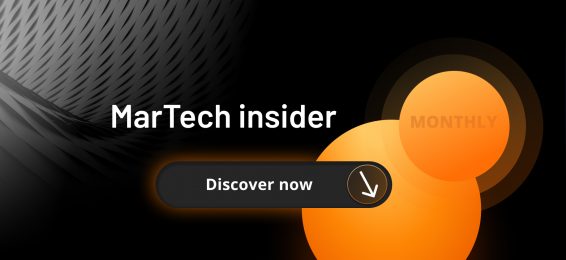Welcome to the September edition of Xenoss MarTech Insider! In this roundup, we’ll take you through the most notable news and developments that shaped the MarTech and AdTech landscape last month. From Salesforce’s AI-fueled acquisitions to Roku’s bold move in CTV ad tech, and The Trade Desk’s potential game-changing ventures into the smart TV OS space—there’s a lot to cover. Plus, Viant is revolutionizing programmatic with AI-driven automation, while the IAB Tech Lab’s new privacy-focused protocol could reshape first-party data strategies. Let’s dive in and explore these impactful stories!
Stay with us for all the latest insights, expert opinions, and strategies driving the industry forward. Follow Xenoss MarTech Insider to stay ahead of the curve!
Let’s dive in!

Salesforce has taken significant steps to deepen its AI capabilities, strengthen data security, and improve data management with a trio of acquisitions, each targeting a specific facet of its strategy.

The first move came with the acquisition of Tenyx , a voice AI startup focused on customer service applications. This follows Salesforce’s earlier purchase of Airkit.ai, positioning the company to challenge outdated IVR systems by incorporating advanced conversational AI into its platforms, further enhancing the new Agentforce tool.
Building on this momentum, Salesforce announced the $1.9 billion acquisition of Own Company, a major provider of backup solutions within the Salesforce ecosystem. This acquisition underscores their commitment to data security and fortifies their position as a leader in business continuity, marking their largest deal since Slack.
In what seems like a fall shopping spree, Salesforce recently acquired Israeli data management firm Zoomin for $450 million. Zoomin specializes in converting unstructured data into structured formats for AI models, a vital component in improving customer support automation and sales forecasting. Zoomin’s technology will be integrated into Salesforce’s Data Cloud and Service Cloud, offering a robust solution for enterprises to leverage their data more effectively. These acquisitions collectively point to a broader ambition: equipping Salesforce’s AI tools with unmatched precision and usability, setting the stage for advancements across service, sales, and data management platforms.

Credera and Areteans launch Connected Marketing Platform to enhance customer engagement
In the age of AI, holding companies, agencies, and consultancies are evolving into martech powerhouses. Global consultancy Credera, in partnership with Areteans, a top Pegasystems partner, has launched the Connected Marketing Platform. This solution integrates advanced data, analytics, AI-driven decision-making, and a Tealium -powered CDP. Its key features include real-time customer insights, enhanced data enrichment, and personalized engagement capabilities, all aimed at boosting marketing efficiency and driving top-line growth.

IAB Tech Lab launches PAIR protocol for privacy-centric data matching
IAB Tech Lab recently launched the PAIR (Publisher Advertiser Identity Reconciliation) protocol, a privacy-first standard designed to enable secure matching of first-party data between advertisers and publishers without relying on third-party cookies. Initially developed by Google, PAIR ensures data interoperability across different clean rooms, using cryptographic techniques to safeguard personal information while still allowing targeted audience engagement. By offering an open, privacy-centric solution, PAIR is set to help both advertisers and publishers activate their audiences and enhance monetization opportunities in a more secure, regulation-compliant environment. The PAIR protocol is currently open for public feedback, with comments accepted until October 25, 2024.

Roku could soon patent tech that can sense when content is paused—and run ads
Roku is stepping up its game in the connected TV space with a new ad-tech patent. After securing partnerships with iSpot.tv and The Trade Desk, Roku has received a Notice of Allowance from the USPTO for a patent on “HDMI customized ad insertion.” This tech would allow Roku to display tailored ads when content is paused via an HDMI connection between a display and a media device. The ads could be customized based on the context of the paused content. While it’s unclear if Roku will use the technology, this move highlights the growing trend of pause ads, which are already being tested by streaming giants like, HBO Max, and Netflix.


The Trade Desk is building its own smart TV OS
Source: Lowpass
It seems The Trade Desk is aiming for more than just a smart TV OS—they’re eyeing a bigger slice of the ad pie by blending retail data with CTV. If these rumors are true, it could be a game-changer. The company’s move to control both the ad inventory and data flow would give them unprecedented influence. With their partnerships in retail media already paving the way for precision ad targeting, adding control of a smart TV OS might create the holy grail of audience targeting. Imagine the power of matching what viewers binge-watch with their shopping habits—an advertiser’s dream.
But let’s not forget the challenges. Competing with the likes of Roku, Amazon, and Google is no easy feat, especially when the TV OS space is already crowded. Yet, if anyone can pull it off, it’s The Trade Desk. By offering better revenue-sharing terms to hardware makers and publishers, they could disrupt the rigid ecosystem and rewrite the rules of CTV advertising. The Trade Desk could undermine the established dominance of players like Roku and Amazon, who currently demand a significant share of ad inventory from publishers. This could entice manufacturers and content providers to switch to The Trade Desk’s platform, where they’d likely see higher revenues and more control over their inventory. Additionally, with The Trade Desk’s potential smart TV OS, they could provide more transparency and flexibility in how ads are served, removing the bottlenecks and limitations that currently exist in ad placements on other platforms. This streamlined process would not only attract more publishers but could also lead to increased innovation in ad formats, targeting methods, and measurement capabilities—essentially reshaping the way ads are bought and sold across CTV. Still, there’s a catch for publishers: this deal might feel like a goldmine at first, but it could trap them in The Trade Desk’s ecosystem, leaving little room for autonomy.
The real question is, can they pull it off without ruffling too many feathers? Their track record suggests they just might. One thing’s certain: The Trade Desk isn’t just eyeing ad delivery—they’re crafting the future of digital advertising. This could either be the beginning of a new era in CTV or a rocky path of overreliance for industry players.


Viant AI brings game-changing automation to programmatic advertising (Viant)
Viant Technology’s launch of ViantAI sets a new standard in programmatic advertising by automating campaign management from start to finish. Built on Viant’s DSP, this tool requires minimal input—advertiser details, budget, timeframe, and goals—while handling everything from audience targeting to budget allocation and media plan creation. By cutting out the manual work of campaign setup, ViantAI allows advertisers to focus on high-level strategy, bringing greater efficiency to the process.

What sets ViantAI apart is not just its automation but its potential to reshape roles within the industry. The need for manual campaign management by trading desks and programmatic agencies begins to fade, and job descriptions are evolving. Advertisers will now need to focus on making strategic decisions rather than executing tasks. As AI takes over the operational side, media buyers become more like strategists, driving decisions based on data and insights.
This shift reflects a broader trend. Leading “walled gardens” will continue developing AI tools to maintain their stronghold, offering high-performance results while keeping their processes hidden. These platforms will leverage their success to maintain control. Meanwhile, open-web platforms will focus on transparency and flexibility, catering to advertisers looking for more customizable and adaptable solutions. As AI continues to shape the future of programmatic advertising, platforms will either embrace control through performance or offer flexibility, giving advertisers a wider range of choices in a rapidly changing ecosystem.

In September, MarTech, AdTech, and Media industry leaders were discussing:
🔸 Software + services convergence and general trends in SaaS
Scott Brinker, VP Platform Ecosystem at HubSpot, shared insights from the latest ICONIQ Growth report, noting that for software businesses generating less than $25M, 24% of their revenue came from services. He raised the question of whether this indicated a growing convergence between software and services, sparking a discussion on how smaller companies tend to rely more on services such as customizations and integrations. The conversation also considered how larger companies typically see a reduction in service-based revenue as their products mature and scale.
🔸 SalesTech landscape
Nicolas de Kouchkovsky, an industry analyst, shared insights from the latest SalesTech landscape, noting that the number of vendors surged by 34% to 2,100 over the past 14 months. He highlighted challenges like fluid categories, generic claims, and frequent pivots, making the landscape difficult to track. The discussion introduced five new categories, including Autonomous BDRs and AI Role-Play, while also spotlighting three rapidly growing ones, such as Signals & Intent Data and Sales (AI) Assistants. Commentators acknowledged the complexity of the landscape, with some sharing excitement about their inclusion in the report and others raising questions about the evolving nature of SalesTech and AI’s role in shaping new solutions. The overall sentiment was one of excitement and appreciation for the detailed analysis, with many asking for deeper insights into market size, consolidation trends, and hoping to explore the findings further in future discussions.
🔸 DOJ vs. Google ad tech trial
Patrick McCann, Senior VP of Research at Raptive, discussed frustrations from the DOJ vs. Google ad tech trial, focusing on Google’s refusal to build a Prebid adapter. His take? Google just needs to return the price and let others handle the integration. Simple as that. But instead, Google’s ad product team has been dodging customer requests for years.
Commenters expressed similar frustrations, criticizing Google’s “hubris and myopia” for destroying value and preserving their monopoly. They questioned whether Google would change course, while some called for urgent reforms before it’s too late.


Only 20.5% of businesses are truly ready for AI: This statistic stands as a sobering reminder that despite the rapid advancement of AI technologies, the majority of businesses are still working on formalizing their approach. A global survey conducted by BARC, involving over 300 business and IT professionals, highlights this gap in AI readiness. For example, 56% of companies have made progress in security standards and compliance, either formalizing or reviewing/revising their initiatives.
However, readiness in other areas is lagging:
- Identifying AI leadership: Only 50% of respondents have formalized or are reviewing plans.
- Legal considerations: 51% have reached the formal or review stage.
- Enterprise architecture requirements: A significant number are still consulting stakeholders or researching, with only 44% showing high readiness.
Special thanks go to Aerospike, Boomi, Domino Data Lab, InterSystems, and Qlik for their sponsorship and support of this initiative, helping to shed light on the critical issue of AI readiness in business.


In September, Xenoss CRO Maria Novikova 🔜 📍 Advertising Week NY represented the company at Programmatic I/O New York, where networking and panel discussions featured AdTech industry leaders. Key topics included programmatic tactics for buyers and sellers, Google’s tools for navigating AdTech fragmentation, and the impact of generative AI and the evolution of FAST into premium content.
To stay up to date on the upcoming AdTech events, check out our AdTech event calendar.

This wraps up our newsletter. We’ll keep you informed every step of the way, so be sure to follow Xenoss MarTech Insider to stay updated.

